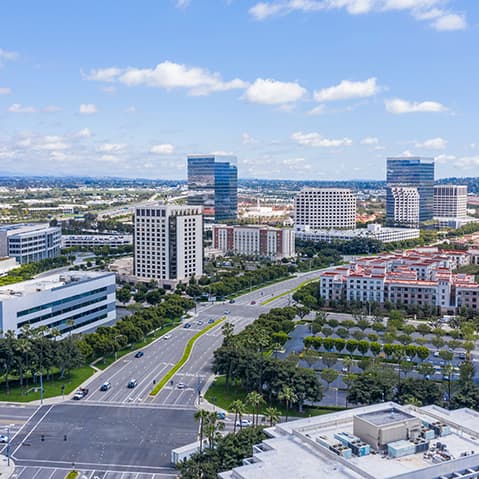For anybody determined to get free of their eyeglasses or contact lenses, laser eye surgery is the obvious solution. However, there are a number of different corrective surgeries available – how do you know which procedure is ideal for you? Those investigating this topic often find the decision narrowed down to three procedures: LASIK, PRK, and SMILE refractive surgery. All three are safe and trusted in the medical field, but which of these treatments is right for you?
PRK Refractive Surgery (Photorefractive Keratectomy)

PRK is often thought of as the first wave in corrective eye surgery. It is a flexible procedure, capable of treating cases of nearsightedness, farsightedness, and astigmatism.
During this treatment, the epithelium (or outer layer) of the eye is carefully scrubbed from the eye to give access to the cornea beneath. The surgeon then uses an excimer laser on the cornea, reshaping it until it’s better suited to clear vision.
What Conditions Make PRK The Best Option?
PRK is an excellent choice for any patient that suffers from chronic dry eye or either an irregularly shaped or thin cornea. Any patient that works in a field where there’s a risk of rough contact to the eye, such as athletes, police officers, or soldiers, might also encouraged toward PRK. LASIK isn’t as good of an option in all of the above conditions, but SMILE might be.
Why Wouldn’t I Want to get PRK?
While PRK is a very flexible procedure due to the increased access that removing the entire epithelium offers, this also increases recovery times. Regrowing the cells of the outer layer of the cornea usually takes about a week after the initial procedure. The cells then need to smooth over and settle down before vision becomes perfectly clear, which is a process that can take an additional two to six weeks.
If a patient has a PRK procedure performed on both eyes at once, then they’ll need to be out of work and be unable to drive for the initial week of recovery. There’s also a higher chance of post-procedure pain or discomfort due to the large amount of healing that’s necessary after a PRK procedure.
LASIK Refractive Surgery (Laser-Assisted Stromal In-situ Keratomileusis)
LASIK is the eye surgery most people are likely to be aware of due to its popularity. And because it’s the most commonly performed corrective surgery right now. It’s used to treat mild and medium sight issues. Like farsightedness, nearsightedness, and astigmatism. Instead of clearing off the entire epithelium like in PRK, a laser is used to create a small flap in the outer layer and opened like a door to give access to the cornea. Once done, the procedure is essentially the same: the cornea is reshaped with a laser so that vision will improve.
What Conditions Make LASIK The Best Option?
An ideal LASIK candidate must have a certain amount of corneal thickness. The creation of the flap can be difficult or even dangerous if the patient’s cornea is too irregular or too thin. Making LASIK an unsafe option. Any patient that has a thin or irregular cornea. They are better candidate for either PRK or SMILE laser eye surgery. LASIK can be an excellent option for any patient that isn’t suffering from chronic dry eye because the nerve damage. It initially causes can temporarily exacerbate conditions and do further harm to the eye. Otherwise, the recovery time is much shorter than a PRK recovery period, and it remains a flexible procedure.
Why Wouldn’t I Want to get LASIK?
LASIK is certainly safe, trusted, and effective, but it is a little bit more complex than both PRK and SMILE. LASIK involves the use of two lasers and the flap can potentially cause complications after the surgery is finished. The flap can potentially cause microscopic striae in the surface of the eye, potential epithelial problems, and, of course, further, dry eye problems. These complications are extremely rare. But a skilled surgeon further decreases the chances of one occurring, but the risk remains slightly higher than alternatives.
SMILE Refractive Surgery (Small Incision Lenticule Extraction)
SMILE is the latest, and most advanced, FDA approved corrective procedure. And received approval in the US market in 2016. SMILE refractive surgery is less invasive than LASIK. Instead of creating an 8mm diameter flap in the eye. SMILE laser eye surgery relies on a keyhole incision that’s only 3mm wide. This can lead to greater stability post-healing, faster recovery times, and less nerve damage.
Unlike LASIK, SMILE refractive surgery only uses one laser. And in contrast to both PRK and LASIK, the laser is a femtosecond laser instead of an excimer laser. A tiny incision is made in the cornea, and the surgeon uses that access point to remove a lenticule. The now-reshaped cornea results in improved vision.
What Conditions Make SMILE The Best Option?
An excimer laser produces an odd odor and a clicking noise during the procedure, which can concern some patients. In contrast, the SMILE laser eye surgery is extremely quiet and odorless. SMILE doesn’t create a flap in the epithelium. So there’s a lower risk of complications emerging after the surgery, and recovery times are swift. Clinical studies have concluded that SMILE is just as safe as LASIK eye surgery.
Why Wouldn’t I Want to get SMILE?
Unfortunately, SMILE refractive surgery hasn’t been approved to treat farsightedness or hyperopia in the US. SMILE is only used to treat nearsightedness and astigmatism right now. The healing process might have lower risks of complications than LASIK. But because the flap is immediately replaced in LASIK, LASIK has a slightly faster recovery time. Vision improvement is near-instant with LASIK, while SMILE patients take a day or two to recover functional vision.
An eye surgeon can perform a comprehensive exam and consultation. To help you determine if your case has any factors that would elevate one procedure over another. The way to learn if any of these procedures is right for you is to schedule a consultation today!























